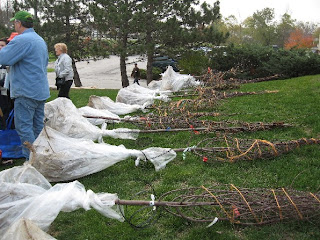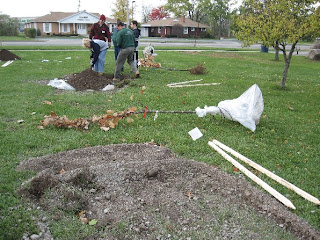
 November 10 was tree planting day in Grand Island. The town had received grant money to purchase the trees, and the town’s Conservation Commission had spent a good amount of time discussing what kind of trees should be planted and where the trees should go. The main stipulation that was given was that the trees had to be planted on public property. One of the members of the Conservation Commission, Rochelle Smith, had recommended that the town use the “bare root” method in planting trees. Rochelle knows a good deal about this because she is an expert in planting trees. She teaches horticulture at Finger Lakes Community College and she is a certified arborist.
November 10 was tree planting day in Grand Island. The town had received grant money to purchase the trees, and the town’s Conservation Commission had spent a good amount of time discussing what kind of trees should be planted and where the trees should go. The main stipulation that was given was that the trees had to be planted on public property. One of the members of the Conservation Commission, Rochelle Smith, had recommended that the town use the “bare root” method in planting trees. Rochelle knows a good deal about this because she is an expert in planting trees. She teaches horticulture at Finger Lakes Community College and she is a certified arborist.
The bare root method is a technique of planting trees that anyone can use. You don’t need to have heavy machinery to dig up and lift gigantic root balls. You don’t need to have crews of city employees to use the heavy machinery. All that you need are a bunch of enthusiastic volunteers and someone, such as Rochelle, who is an expert, to give instructions.
For more information about the bare root method, take a look at http://www.hort.cornell.edu/UHI/outreach/pdfs/bareroot.pdf
This is a big, eighteen-page document that tells you everything that you might want to know about the bare root method of planting a tree.
In a nutshell, here is the abridged version. The young tree is dug up and all of the dirt is shaken off of the roots. Then the roots are soaked in a gel-like substance, called a hydrogel dip. This helps the roots stay moist, which is essential to keeping the tree alive. The tree must be planted in the ground within seven to ten days of being dug up and its roots soaked in the hydrogel dip. This is the main disadvantage of the bare root method. If the weather turns frightening or if something happens that prevents the planting from occurring, the trees could die. But this method definitely has its advantages. The tree is light enough for small people to carry, unlike trees that are transplanted by the “ball and burlap” method. This is the traditional method of transplanting trees. A machine, called a tree spade, is used to dig up the tree. Unfortunately, this often results in damage to the young root system. With the bare root method, there is much less damage to the roots when the tree is dug. Once the tree spade digs up the tree, the root ball is wrapped in burlap. There is a good deal of dirt around the root system, which results in the tree weighing anywhere from 100 to 300 pounds!
Well, that’s a good deal of weight! I was looking forward to fun tree planting, not to weight training with excessive weights! But, generally, the “ball and burlap” method can be used only by city crews with heavy machinery and lots of equipment. But, because these roots are sitting in a lot of dirt, they can sit around for long periods of time if untoward weather conditions occur.
Fortunately, no unpleasant weather conditions occurred on November 10, when the tree planting was scheduled.
In all, sixty trees were planted in Grand Island. These included crab apple trees, Japanese Tree Lilacs, white oaks, and others. They were chosen because they could survive in Grand Island’s clay soil. The white oaks were chosen because of Grand Island’s history of white oak trees. In the nineteenth century, Grand Island was a heavily wooded area, with many white oak trees. Unfortunately, by the end of the nineteenth century, the white oak trees had all been cut down. Much of the lumber was sold to ship builders, who built clipper ships, some of the lumber was used to make wine barrels. The Whitehaven Road Sawmill was where the wine barrels were made. These wine barrels went all over the world.
It was Mary Cooke, the town board liaison to the Conservation Commission, who told me about the clipper ships and Nicole Gerber, a volunteer at the tree planting event, who told me about the wine barrels. I wonder if any of the wine barrels or clipper ships are still around because it would be interesting to see them.
Mary Cooke and Rochelle Smith told me that they were very happy with how the day’s tree planting went and that they are looking forward to future tree plantings. The next tree planting should be held early in the spring, while the trees are still dormant. Rochelle told me that trees have to be planted while they are dormant, which means when the leaves are off them. That way, you get the best results. And the best results are important to Mary, who told me that Grand Island planted 150 trees during its sesquicentennial five years ago, but that forty of them died. She said that, this time, she is hoping that the trees “survive and thrive, as opposed to hang out and die.”
